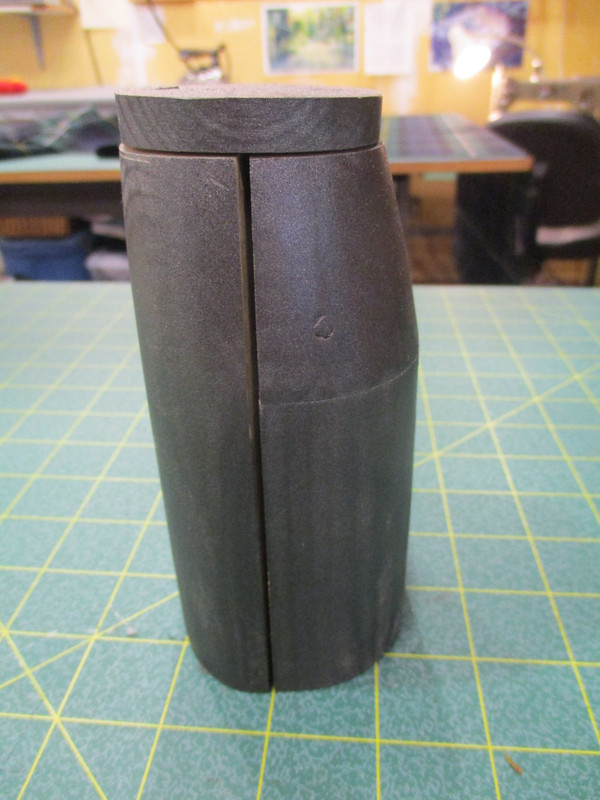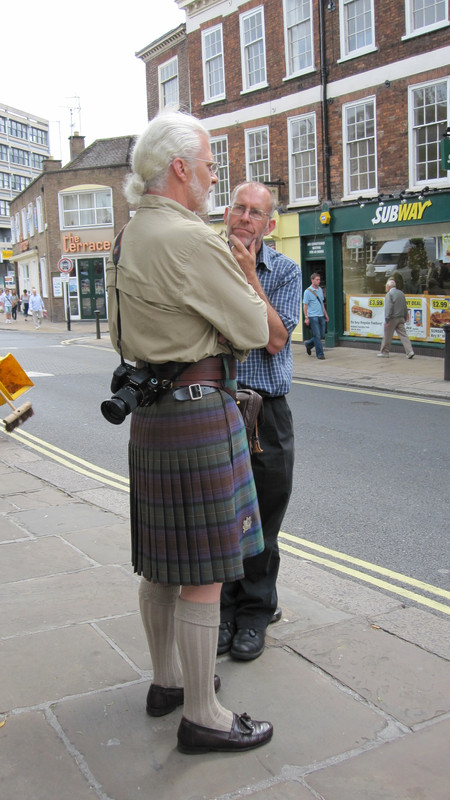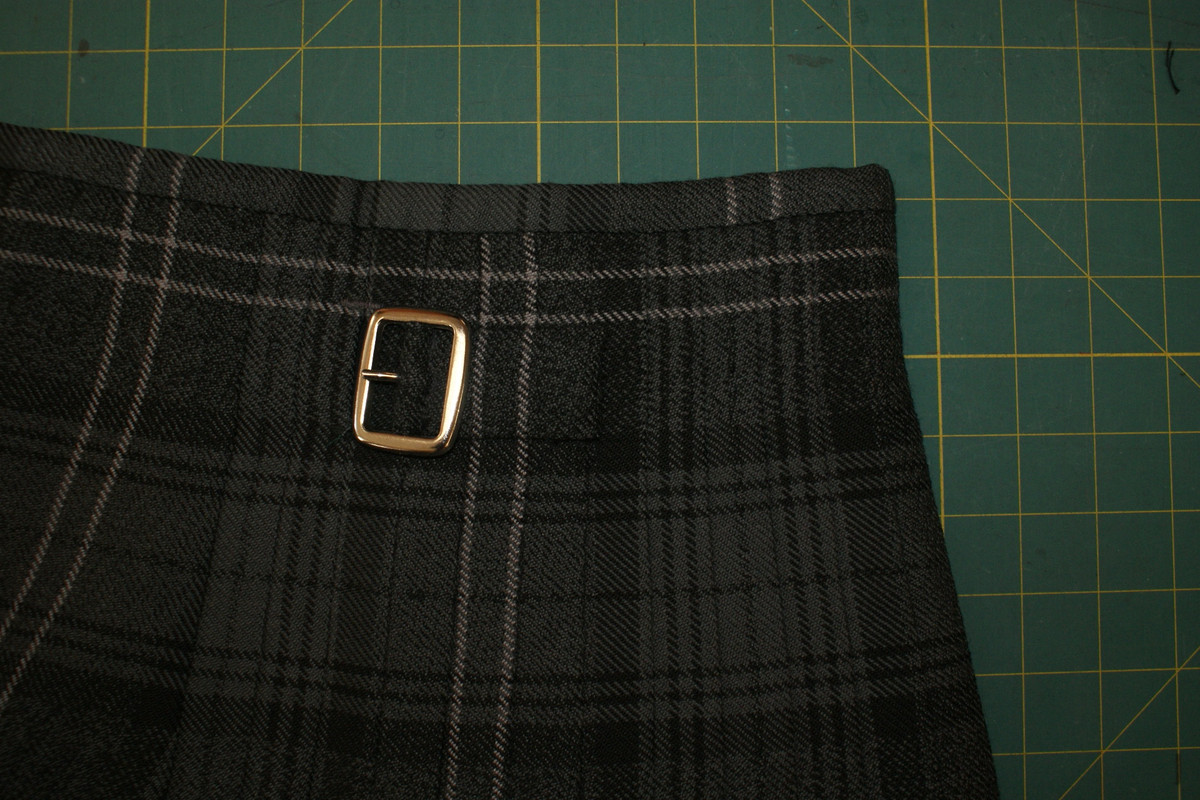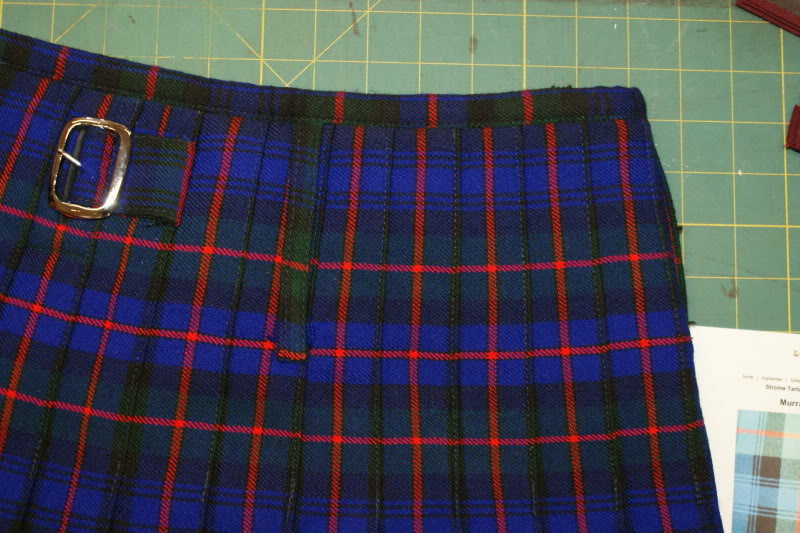|
-
30th December 21, 05:12 PM
#21
I'm going to try to answer Jock's question from post #11. His question is about the wearing of kilts at mid knee in N. America and if that is the norm and if we kiltmakers measure for that length.
When I would measure for a custom kilt in my shop, I would ask the customer where they wanted the bottom of the kilt to hit their knee. If the guy asked for a mid knee length I would ask "why mid knee?"
The answer was almost always - "Because that is normal, right? That is what I see in pictures."
The "Art of Kiltmaking" by Barb Tewksbury specifies that the bottom of a kilt as defined by her Traditional method, should always be just at the top of the patella or knee cap.
So where does this thinking that the normal length of a kilt should be at mid knee come from?
It is my personal opinion that it comes from guys thinking that a kilt is like trousers and should be worn at trouser waist height. No trousers made in the last 40 years have the waist designed to be worn at the anatomical waist. Which was the norm at the time the Traditional kilt was designed.
Wearing trousers like this was normal up until the advent of modern blue jeans. But it looks odd today.

So guys today simply do not understand that a kilt is worn differently than trousers.
Here is a group of young Scots and you can see that while they are wearing kilts constructed in the Traditional high waisted style, they are all wearing them at trouser height. The bottoms of all are at mid or bottom of the knee. (Yes, these are Scots not N. Americans)

It is my personal opinion that this is where the thinking that mid knee is normal. Guys wearing a kilt, that was designed to be worn at the anatomical waist, down where they would wear their modern trousers.
Here is a small wooden model of the individual components of a kilt.
At the top you see the "rise" above the top strap.
In front are the aprons falling straight down from the belly.
In the back you can see the tapered part called "The Fell Area".
And below the Fell Area are the loose pleats.

A kilt made in accordance with The Art of Kiltmaking will have a Fell Area that is always 1/3 of the Drop or the distance from the center of the top strap, down to the bottom, selvedge edge. The total length of the kilt is then the Drop + the Rise. (Ask yourself when was the last time you saw a set of kilt measuring instructions that explain this?)
The Art of Kiltmaking assumes that the kilt will be worn with the top strap is cinched into the anatomical waist.
Or where the top strap is in this photo.

If the kilt is worn lower than it was designed and made to be worn, the bottom of the Fell Area will be blow the crest of the hips. The bottom of the kilt will then be below the top of the knee cap.
This photo shows a kilt worn lower than it was designed and made to be worn.

Notice please the tell tale "shower curtain" folds that develop in the pleats with the bottom of the Fell Area lower than the hip line. You can see exactly this at almost any Highland Games.
Notice also, that with the bottom of the Fell Area worn low, the customer will sit on the bottom of the Fell Area which has caused the Fell stitching to fail. Those hand stitches simply can't hold against the stress.
If a kilt is worn at the height it was designed, and constructed to fit, the pleats in the rear should form a smooth, unbroken line. From just a few feet away you should not even see that there are pleats until the person moves.

So, the way to fix this, has to do with the design of the kilt, and where it was made to fit.
But let's go back to looking at a kilt from the side like the wooden model.

For a kilt to fit and look right, the one thing that must be correct is the bottom of the Fell Area. It must hit right at the widest part of the hips or buttocks. Or just about where the hip joint is.
There is a bone (the Femur) in the thigh so the length of the pleats - from the bottom of the Fell Area - down to the bottom of the kilt or Selvedge - will always be the same for any one guy.
The only way to make a kilt shorter, to fit when being worn at trouser height, is to shorten the Fell Area. Or from the top down. This is why hemming a kilt up, to make it shorter, does not work.
Howie Nicklesby of 21st Century kilts. Steven Villagas of Utilikilts and myself of Freedom Kilts are some of the very few kiltmakers who take where the customer wishes to wear the waist of his kilts into our designs, and build the kilt accordingly. I actually measured for the length of the Fell Area and asked for this measurement on my website. But this was more complicated than the usual 3 measurements of most websites.
This is one of my mid waist height kilts and it appears to fit pretty well. But it was made, from the ground up, to fit like this. The length of the Fell Area is shorter to account for the waist worn lower. The bottom of the kilt is at the top of my knee cap, but in the front, the waist is actually below my belly button.

So what started the thinking that mid knee was normal? Well, I blame an ill-informed customer base. Guys who want a kilt but were never taught how to wear one. They just assume that a kilt is worn like trousers.
And I blame kiltmakers who don't explain this stuff to their customers. I believe that it is vital that a kiltmaker explain that the total length of a kilt is Drop + Rise, and that the bottom of the Fell Area should be at the hip line. (or right about where the hip joint is.)
And it is also my personal opinion, that until other kilt makers take the length of the Fell Area - along with the total length (Rise + Drop), into account when explaining how a kilt should fit, that the selvedge below the top of the knee thing will stay the norm.
This puts the emphasis of teaching our customers, and making kilts that fit well regardless of where the customer wishes to wear the waist, straight upon the shoulders of we, the kiltmakers.
Last edited by Steve Ashton; 30th December 21 at 07:24 PM.
-
The Following 5 Users say 'Aye' to Steve Ashton For This Useful Post:
-
30th December 21, 07:38 PM
#22
And to further answer Jock - Yes, there used to be a pretty standard "Tailoring Trick".
In days gone by, it was explained that when kneeling in church, the bottom of the kilt should not brush the floor.
So the kiltmaker would have the customer kneel while measuring. The kiltmaker would then measure from the anatomical waist down to the floor.
BUT - the trick was not in the measuring but in the construction. It was a kiltmaking secret so not explained to the customer. When making the kilt, the maker would build in a 2 inch Rise above the top strap. This Rise tapered out to go over the bottom of the ribs.

The result was that when the customer put his kilt on, the bottom would end up 2 inches above the floor when kneeling, and hit his knee right at the top of the knee cap when standing.
This "Tailors Trick" was not explained to the customers and led many to believe, for a long time, - that as the kiltmaker measured to the floor - that the kilt should hit the floor when kneeling.
I guess I heard this old wives tale more times that I can remember.
Today it is quite common to find kilts made without the taper in the Rise. You see this in the less expensive kilts, many off-the-peg kilts, and almost all of the middle Eastern imported kilts.

The result, of course, is that the smallest part of the kilt is no longer at the top strap - but at the top band of the kilt. A kilt made this way will always droop down over the course of a day. Further leading to the mid knee look.
Last edited by Steve Ashton; 30th December 21 at 07:51 PM.
-
The Following 4 Users say 'Aye' to Steve Ashton For This Useful Post:
-
30th December 21, 11:51 PM
#23
I fear I may have caused a bit of a kerfuffle here, by incorrectly paraphrasing USA Kilts' measuring instructions. I went back and looked, and the instructions that I used were to kneel, then measure from the top of the kilt to the floor, and subtract one inch (not measure from body part to body part and add an inch, as previously stated.
For me, standing just under 6'2, this measurement is 25 inches. Now what's interesting is that I feel that both kilts that I ordered with these measurements were about an inch shorter than I wanted. I've since ordered two kilts 26 inches in length, and I wear them a bit higher. This assures that even when wearing a coatee, I'm sure not to have a gap between kilt and waistcoat. In either case, I'm wearing the kilts about the top of the knee cap.
I'm ordering a box pleat kilt from Josh Brown in Sacramento soon, and I think that'll be 25 inches - the slightly lower waist looks better with a t-shirt, I think.
Last edited by KennethSime; 4th January 22 at 11:23 PM.
-
-
31st December 21, 04:16 AM
#24
Thank you Steve for your very interesting replies. I am not sure how to take my observations and your illuminating answers any further without causing a possible meltdown of some members here.
Although, I can quite see how “customer ignorance” and a willingness of some kilt makers to indulge that ignorance cannot help the overall image of the kilt.
Let me just say, in my youth we youngsters(aged between 1 and perhaps 25 years of age ) were clad in hand-me-down kilts, some fitted reasonably well and some fitted appallingly badly and we all knew that and it was a dream that one day we would have our own kilt that fitted perfectly. In the meantime where the bottom of the kilt went was the only critical issue and that was, it brushed the top of the kneecap. Nothing else mattered and it would not be unusual for a complete stranger to inform us youngsters, in no uncertain terms, that the kilt height was too high or more usually too low and we were expected to put matters right forthwith. Where the top of the kilt went was of no interest to anyone as there was no expectation that anything could be done about it. The end result was that we knew as youngsters, certainly locally and possibly throughout the Highlands, where the bottom of the kilt should be!
It was a tough learning curve for sure and it is quite understandable that those new to kilt wearing today and without someone to sensibly advise them are all at sea when it comes to where the kilt should hang. Dare I say, that perhaps some kilt makers of today, from all parts of the world, need to know themselves where the kilt “hem” should hang for best effect, to then advise their customers correctly.
Last edited by Jock Scot; 31st December 21 at 04:22 AM.
" Rules are for the guidance of wise men and the adherence of idle minds and minor tyrants". Field Marshal Lord Slim.
-
The Following 2 Users say 'Aye' to Jock Scot For This Useful Post:
-
31st December 21, 07:55 AM
#25
Well apparently I opened a can of worms. Blame the new guy
I do understand that a kilt does not fit like jeans or trousers and that is why I am asking questions.
Unfortunately I do not have a kilt maker here locallly and I wouldn't even know where to go. I chose a kilt maker and followed their instructions and measured and remeasured. I contacted them, they gave advice and I took that into account.
I want to embrace my Scottish heritage, to learn and grow into that rich heritage. I have been studying my genealogy for years, have taken the YDNA and belong to the Clan Stewart Society of America. The next year I am hoping there will be events returning so I can connect and be apart of something grand and find the kilt to wear there.
I appreciate all the posts and knowledge that has been shared here and only wish that I would have know to come here first before buying.
Happy New Year to you all!
Last edited by stewmini; 31st December 21 at 09:04 AM.
-
-
31st December 21, 08:02 AM
#26
 Originally Posted by stewmini

Well apparently I opened a can of worms. Blame the new guy 
No can of worms whatever! This is what we love explaining, discussing, and illustrating, and we're all over trying to help a new guy like ants on a picnic cake!
Glad you posted!
Rev'd Father Bill White: Retired Parish Priest & Elementary Headmaster. Lover of God, dogs, most people, joy, tradition, humour & clarity. Legion Padre, theologian, teacher, philosopher, linguist, encourager of hearts & souls & a firm believer in dignity, decency, & duty. A proud Canadian Sinclair.
-
The Following 2 Users say 'Aye' to Father Bill For This Useful Post:
-
31st December 21, 01:51 PM
#27
No one should ever take one of my long-winded diatribes as meaning that I am upset or out of sorts in any way.
I spent a long time in a business that required me to talk at length. I can go on and one dispelling myths and misconceptions for hours. It's my super power.
In my years I have seen some really great kilts and more that I would like of horrid kilts.
I have met some very talented cræftpeople and some just in it for the money.
But I do know how to fold and stitch a flat piece of fabric to fit a human form. And I like sharing the little 'behind-the-scenes' aspects of the cræft.
Most who have been on this forum for more than a day just tune me out.
-
The Following 2 Users say 'Aye' to Steve Ashton For This Useful Post:
-
31st December 21, 02:48 PM
#28
Where does one get a decent pair of Ghillie Brogues?
-
-
31st December 21, 03:02 PM
#29
 Originally Posted by stewmini

Where does one get a decent pair of Ghillie Brogues?
Most of the advertisers around the edge will sell them to you, but honestly, why do you want them? They're not de rigeur and frankly a well polished pair of toecap Oxfords or wingtip brogues is just as traditional, possibly more so, and serve more than one purpose.
Rev'd Father Bill White: Retired Parish Priest & Elementary Headmaster. Lover of God, dogs, most people, joy, tradition, humour & clarity. Legion Padre, theologian, teacher, philosopher, linguist, encourager of hearts & souls & a firm believer in dignity, decency, & duty. A proud Canadian Sinclair.
-
The Following 2 Users say 'Aye' to Father Bill For This Useful Post:
-
31st December 21, 04:22 PM
#30
Because I thought they were the goto classic dress style but, you are saying not so much? Good to know. What is good casual dress down boot/shoe that is traditional?
-
 Posting Permissions
Posting Permissions
- You may not post new threads
- You may not post replies
- You may not post attachments
- You may not edit your posts
-
Forum Rules
|
|































Bookmarks